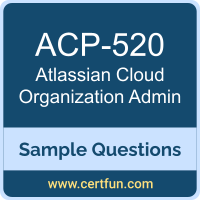 Getting knowledge of the Atlassian ACP-520 exam structure and question format is vital in preparing for the Atlassian Cloud Organization Admin certification exam. Our Atlassian Cloud Organization Admin sample questions offer you information regarding the question types and level of difficulty you will face in the real exam. The benefit of using these Atlassian ACP-520 sample questions is that you will get to check your preparation level or enhance your knowledge by learning the unknown questions. You will also get a clear idea of the exam environment and exam pattern you will face in the actual exam with the Atlassian Cloud Organization Admin Sample Practice Test. Therefore, solve the Atlassian ACP-OA sample questions to stay one step forward in grabbing the Atlassian Certified Professional - Atlassian Cloud Organization Admin (ACP-OA) credential.
Getting knowledge of the Atlassian ACP-520 exam structure and question format is vital in preparing for the Atlassian Cloud Organization Admin certification exam. Our Atlassian Cloud Organization Admin sample questions offer you information regarding the question types and level of difficulty you will face in the real exam. The benefit of using these Atlassian ACP-520 sample questions is that you will get to check your preparation level or enhance your knowledge by learning the unknown questions. You will also get a clear idea of the exam environment and exam pattern you will face in the actual exam with the Atlassian Cloud Organization Admin Sample Practice Test. Therefore, solve the Atlassian ACP-OA sample questions to stay one step forward in grabbing the Atlassian Certified Professional - Atlassian Cloud Organization Admin (ACP-OA) credential.
These Atlassian ACP-520 sample questions are simple and basic questions similar to the actual Atlassian Cloud Organization Admin questions. If you want to evaluate your preparation level, we suggest taking our Atlassian Cloud Organization Admin Premium Practice Test. You might face difficulties while solving the real-exam-like questions. But, you can work hard and build your confidence on the syllabus topics through unlimited practice attempts.
Atlassian ACP-520 Sample Questions:
a) It automatically deletes any unauthorized products or sites created without IT approval.
b) It provides visibility and control over all Atlassian products, including unauthorized sites.
c) It restricts users from creating new Atlassian products or sites.
d) It offers unlimited storage to discourage the creation of Shadow IT sites.
(Select two)
a) Users need separate accounts for each site.
b) Users can be grouped across multiple sites for easier management.
c) Access to products is managed separately from site access.
d) A single login can provide access to all products and sites within the organization.
b) Through a phone call
c) You can send them a short message via the denial notification.
d) It's not possible to communicate the reason.
a) To manage billing for all Atlassian products
b) To provide a centralized space for managing users and permissions across Atlassian products
c) To track project progress across teams
d) To customize user interfaces for individual Atlassian products
b) Manage users individually for each site to maintain strict access control.
c) Utilize groups to manage user access across multiple sites, streamlining permission management.
d) Require each user to maintain separate accounts for each site for security reasons.
a) Links can be set to never expire until they are manually deactivated.
b) Invitation links expire after a single use.
c) Each user can use the same link to invite additional users.
d) Invitation links provide access to all Atlassian products by default.
a) The new site inherits global permissions from the organization automatically.
b) Each new site requires a unique URL.
c) The new product can share a site with other products.
d) A new organization is created for each new product.
a) In the product dashboard
b) On the Access requests page
c) Within the user's profile settings
d) Through email notifications only
a) By enabling SAML single sign-on
b) By setting up a VPN
c) By customizing the dashboard for all users
d) By manually configuring permissions for each user
(Select two)
a) Users can belong to multiple groups
b) Groups are used to manage project roles exclusively
c) Users can be given access to products based on the groups they belong to
d) A user's group membership can override their individual permissions
Answers:
|
Question: 01 Answer: b |
Question: 02 Answer: b, d |
Question: 03 Answer: c |
Question: 04 Answer: b |
Question: 05 Answer: c |
|
Question: 06 Answer: a |
Question: 07 Answer: b, c |
Question: 08 Answer: b |
Question: 09 Answer: a |
Question: 10 Answer: a, c |
Note: For any error in Atlassian Cloud Organization Admin (ACP-520) certification exam sample questions, please update us by writing an email on feedback@certfun.com.
